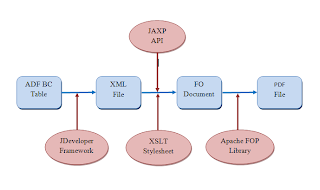// print the roles of the current user
for ( String role : ADFContext.getCurrent().getSecurityContext().getUserRoles() ) {
System.out.println(”role “+role);
}
// get the ADF security context and test if the user has the role users
SecurityContext sec = ADFContext.getCurrent().getSecurityContext();
if ( sec.isUserInRole(”users”) ) {
}
// is the user valid
public boolean isAuthenticated() {
return ADFContext.getCurrent().getSecurityContext().isAuthenticated();
}
// return the user
public String getCurrentUser() {
return ADFContext.getCurrent().getSecurityContext().getUserName();
}
// get the binding container
BindingContainer bindings = BindingContext.getCurrent().getCurrentBindingsEntry();
// get an ADF attributevalue from the ADF page definitions
AttributeBinding attr = (AttributeBinding)bindings.getControlBinding(”test”);
attr.setInputValue(”test”);
// get an Action or MethodAction
OperationBinding method = bindings.getOperationBinding(”methodAction”);
method.execute();
List errors = method.getErrors();
method = bindings.getOperationBinding(”methodAction”);
Map paramsMap = method.getParamsMap();
paramsMap.put(”param”,”value”) ;
method.execute();
// Get the data from an ADF tree or table
DCBindingContainer dcBindings = (DCBindingContainer)BindingContext.getCurrent().getCurrentBindingsEntry();
FacesCtrlHierBinding treeData = (FacesCtrlHierBinding)bc.getControlBinding(”tree”);
Row[] rows = treeData.getAllRowsInRange();
// Get a attribute value of the current row of iterator
DCIteratorBinding iterBind= (DCIteratorBinding)dcBindings.get(”testIterator”);
String attribute = (String)iterBind.getCurrentRow().getAttribute(”field1″);
// Get the error
String error = iterBind.getError().getMessage();
// refresh the iterator
bindings.refreshControl();
iterBind.executeQuery();
iterBind.refresh(DCIteratorBinding.RANGESIZE_UNLIMITED);
// Get all the rows of a iterator
Row[] rows = iterBind.getAllRowsInRange();
TestData dataRow = null;
for (Row row : rows) {
dataRow = (TestData)((DCDataRow)row).getDataProvider();
}
// Get the current row of a iterator , a different way
FacesContext ctx = FacesContext.getCurrentInstance();
ExpressionFactory ef = ctx.getApplication().getExpressionFactory();
ValueExpression ve = ef.createValueExpression(ctx.getELContext(), “#{bindings.testIter.currentRow.dataProvider}”, TestHead.class);
TestHead test = (TestHead)ve.getValue(ctx.getELContext());
// Get a session bean
FacesContext ctx = FacesContext.getCurrentInstance();
ExpressionFactory ef = ctx.getApplication().getExpressionFactory();
ValueExpression ve = ef.createValueExpression(ctx.getELContext(), “#{testSessionBean}”, TestSession.class);
TestSession test = (TestSession)ve.getValue(ctx.getELContext());
// main jsf page
DCBindingContainer dc = (DCBindingContainer)BindingContext.getCurrent().getCurrentBindingsEntry();
// taskflow binding
DCTaskFlowBinding tf = (DCTaskFlowBinding)dc.findExecutableBinding(”dynamicRegion1″);
// pagedef of a page fragment
JUFormBinding form = (JUFormBinding) tf.findExecutableBinding(”regions_employee_regionPageDef”);
// handle to binding container of the region.
DCBindingContainer dcRegion = form;
// return a methodexpression like a control flow case action or ADF pagedef action
private MethodExpression getMethodExpression(String name) {
Class [] argtypes = new Class[1];
argtypes[0] = ActionEvent.class;
FacesContext facesCtx = FacesContext.getCurrentInstance();
Application app = facesCtx.getApplication();
ExpressionFactory elFactory = app.getExpressionFactory();
ELContext elContext = facesCtx.getELContext();
return elFactory.createMethodExpression(elContext,name,null,argtypes);
}
//
RichCommandMenuItem menuPage1 = new RichCommandMenuItem();
menuPage1.setId(”page1″);
menuPage1.setText(”Page 1″);
menuPage1.setActionExpression(getMethodExpression(”page1″));
RichCommandButton button = new RichCommandButton();
button.setValueExpression(”disabled”,getValueExpression(”#{!bindings.”+item+”.enabled}”));
button.setId(item);
button.setText(item);
MethodExpression me = getMethodExpression(”#{bindings.”+item+”.execute}”);
button.addActionListener(new MethodExpressionActionListener(me));
footer.getChildren().add(button);
// get a value
private ValueExpression getValueExpression(String name) {
FacesContext facesCtx = FacesContext.getCurrentInstance();
Application app = facesCtx.getApplication();
ExpressionFactory elFactory = app.getExpressionFactory();
ELContext elContext = facesCtx.getELContext();
return elFactory.createValueExpression(elContext, name, Object.class);
}
// an example how to use this
RichInputText input = new RichInputText();
input.setValueExpression(”value”,getValueExpression(”#{bindings.”+item+”.inputValue}”));
input.setValueExpression(”label”,getValueExpression(”#{bindings.”+item+”.hints.label}”));
input.setId(item);
panelForm.getChildren().add(input);
// catch an exception and show it in the jsf page
catch(Exception e) {
FacesMessage msg = new FacesMessage(FacesMessage.SEVERITY_ERROR, e.getMessage(), “”);
FacesContext.getCurrentInstance().addMessage(null, msg);
}
FacesMessage msg = new FacesMessage(FacesMessage.SEVERITY_WARN, msgHead , msgDetail);
facesContext.addMessage(uiComponent.getClientId(facesContext), msg);
// reset all the child uicomponents
private void resetValueInputItems(AdfFacesContext adfFacesContext,
UIComponent component){
List<UIComponent> items = component.getChildren();
for ( UIComponent item : items ) {
resetValueInputItems(adfFacesContext,item);
if ( item instanceof RichInputText ) {
RichInputText input = (RichInputText)item;
if ( !input.isDisabled() ) {
input.resetValue() ;
adfFacesContext.addPartialTarget(input);
};
} else if ( item instanceof RichInputDate ) {
RichInputDate input = (RichInputDate)item;
if ( !input.isDisabled() ) {
input.resetValue() ;
adfFacesContext.addPartialTarget(input);
};
}
}
}
// redirect to a other url
ExternalContext ectx = FacesContext.getCurrentInstance().getExternalContext();
HttpServletResponse response = (HttpServletResponse)ectx.getResponse();
String url = ectx.getRequestContextPath()+”/adfAuthentication?logout=true&end_url=/faces/start.jspx”;
try {
response.sendRedirect(url);
} catch (Exception ex) {
ex.printStackTrace();
}
// PPR refresh a jsf component
AdfFacesContext.getCurrentInstance().addPartialTarget(UIComponent);
// find a jsf component
private UIComponent getUIComponent(String name) {
FacesContext facesCtx = FacesContext.getCurrentInstance();
return facesCtx.getViewRoot().findComponent(name) ;
}
// get the adf bc application module
private OEServiceImpl getAm(){
FacesContext fc = FacesContext.getCurrentInstance();
Application app = fc.getApplication();
ExpressionFactory elFactory = app.getExpressionFactory();
ELContext elContext = fc.getELContext();
ValueExpression valueExp =
elFactory.createValueExpression(elContext, “#{data.OEServiceDataControl.dataProvider}”,
Object.class);
return (OEServiceImpl)valueExp.getValue(elContext);
}
// change the locale
Locale newLocale = new Locale(this.language);
FacesContext context = FacesContext.getCurrentInstance();
context.getViewRoot().setLocale(newLocale);
// get the stacktrace of a not handled exception
private ControllerContext cc = ControllerContext.getInstance();
public String getStacktrace() {
if ( cc.getCurrentViewPort().getExceptionData()!=null ) {
StringWriter sw = new StringWriter();
PrintWriter pw = new PrintWriter(sw);
cc.getCurrentViewPort().getExceptionData().printStackTrace(pw);
return sw.toString();
}
return null;
}
// get the selected rows from a table component
RowKeySet selection = resultTable.getSelectedRowKeys();
Object[] keys = selection.toArray();
List<Long> receivers = new ArrayList<Long>(keys.length);
for ( Object key : keys ) {
User user = modelFriends.get((Integer)key);
}
// get selected Rows of a table 2
for (Object facesRowKey : table.getSelectedRowKeys()) {
table.setRowKey(facesRowKey);
Object o = table.getRowData();
JUCtrlHierNodeBinding rowData = (JUCtrlHierNodeBinding)o;
Row row = rowData.getRow();
Test testRow = (Test)((DCDataRow)row).getDataProvider() ;
}


